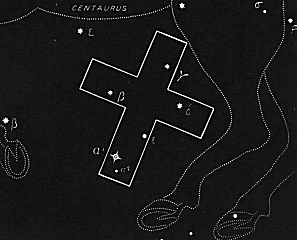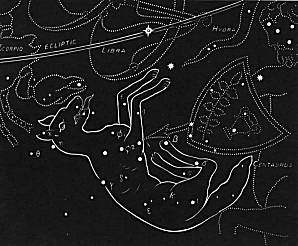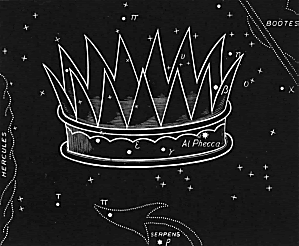Libra: The Price Which Covers
Chapter Two: The Work of Grace on the Cross
In the first chapter of the book we saw that the Seed of the woman was to give up His life for others. In this chapter we are going to see the work of grace necessary to sustain the prophecy of the coming Messiah. That work of grace was Christ buying back, or redeeming, our right standing before God by His death on the cross. In the second book this grace will be seen in the pouring out of the Ruach Ha’Kodesh for the Church.

The Hebrew name is Mozanaim, or the scales, or weighing. Its name in Arabic is Al Zubena, which means purchase, or redemption. The name by which it has come down to us is the Latin Libra, which means weighing. The sign of Libra is pictured as two scales, an upper scale and a lower scale, and contains three bright stars whose names explain the significance of the two scales. The first star, alpha, in the lower scale, is named Zuben al Genubi, which means the purchase, or the price is deficient. This points to the fact that mankind is utterly lost, being weighed on these scales and found not to measure up. No man can redeem the life of another or give to God a ransom, for a life is costly; no payment is ever enough (Psalm 49:7-8). And not only that, but lowborn men are but a breath, the highborn are but a lie; if weighed on a balance scale, they are nothing; together they are only a breath (Psalm 62:9). This is the verdict pronounced by this first star.
This begs the question, is there no hope? Is there no one who can pay the price? Yes! There is the Seed of the woman. He is not merely coming as a child; He is coming as an atoning sacrifice. He is coming for the purpose of redemption. He is coming in grace. So we have the testimony of a second bright star, beta, in the upper scale, named Zuben al Chemali, which means the price which covers. This points to the fact that God is able to buy back His children. And they sang a new song: You are worthy to take the scroll and to open its seals, because you were slain, and with your blood you purchased men for God from every tribe and language and people and nation (Revelation 5:9). This star has another name, al Gubi, or heaped up, or high. This second star tells us of the infinite price that our redemption will cost.
But there is a third star, gamma, below, towards Centaurus and the Slain, telling us that by its name redemption could only be accomplished by conflict. It is called Zuben Akrabi or Zuben al Akrab, which means the price of the conflict. Therefore, the price which covers the sins of the world was paid, and was more than the price which was deficient. What that price was to be, how it was to be paid, and what was to be the result of the payment is seen in Libra’s three constellations.

1. Crux (The Cross): The first constellation was named Adom, after the Hebrew, which means cutting off (Dani’el 9:26). Another name for it is the last letter of the Hebrew alphabet, Tau, and to this day it means a mark; especially a boundary-mark, a limit or finish. When Christ paid the price which covers on the cross, Jesus cried out: It is finished (John 19:30). Yeshua spoke in Aramaic, not in Greek. The Aramaic translation here is: Paid in full. What was paid in full? The payment for our sins, which is perfect, complete, finished, never to be repeated or added to.

2. Lupus (The Slain): The modern name is Lupus, or a wolf, because it looks like one, but it could be any animal. The main point of this ancient constellation is that the animal has been slain and is in the act of falling down dead. Its Greek name is Thera, a beast, and Lycos, a wolf. The ancient Hebrew Asada and Arabic Asedaton, both mean to be slain. Because He is slain here by the Centaurus, it points to the fact that it was His own act. Messiah would say: I lay down my life for the sheep, no one takes it from Me, but I lay it down of My own accord (John 10: 15, 18).

3. Corona (The Crown): Each chapter ends with glory, and here the shameful cross is closely followed by the glorious crown. But we see Jesus . . . now crowned with glory and honor because He suffered death, so that by the grace of God He might taste death for everyone (Hebrews 2:9). The Hebrew name for the constellation is Atarah, a royal crown, and its stars are known today in the East by the plural, Ataroth. Its Arabic name is Al Iclil, an ornament or jewel. So the second chapter ends, which describes the great work of redemption, beginning with the cross and ending with the crown. Jesus alone is seen as the substitute for lost sinners. I looked, and there before me was a white cloud, and seated on the cloud was Jesus with a crown of gold on His head (Revelation 14:14).
As followers of Messiah, we also receive a crown or crowns. Crown is from stephanos, which has the literal meaning of surrounding and was used of wreaths or garlands that were placed on the heads of dignitaries, military victors, and winners of athletic contests as a mark of great honor. For we must all appear before the judgment seat of Christ, that each one may receive what is due him or her for the things done while in the body, whether good or worthless (Second Corinthians 5:10 and First Corinthians 3:11-15). So certain rewards that believers will receive or not receive will be individual, based on their own faithfulness.
The image of the crown in the New Covenant is developed in detail in First Corinthians 9:24-27 with an image of a race and the perishable crown that the victor wins. But Paul writes that believers run the race to get a crown that will last forever (First Corinthians 9:25). These are not literal crowns, but the characteristic of the crown will be true of the believer for eternity (see my commentary on Revelation, to see link click Cc – We Must All Appear Before the Judgment Seat of Christ). We all look forward to the time when Jesus will say to us: Well done, good and faithful servant (Matthew 25:21)!



Leave A Comment